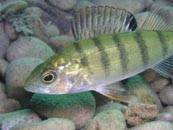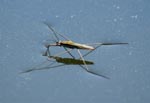Look Underwater!
Make a pond viewer to get a look at the creatures that live in the water of a pond!
What You Need:
- an empty coffee can
- a can opener
- plastic wrap
- a rubber band (big enough to fit around the can)
- duct tape or waterproof first aid tape
- an adult’s help
What You Do:
1. Ask an adult to help you use the can opener to remove the end of the coffee can (both ends need to be off).
2. Tape over the rough edges of the can so that you won’t cut yourself when you use your pond viewer.
3. Cut a piece of plastic wrap that is big enough to cover one end of the can and go at least half way up the sides.
4. Stretch the plastic wrap over an end of the can, making sure it is smooth and tight across the opening.
5. Hold the plastic wrap and have an adult put the rubber band around the mouth of the can to hold the plastic wrap in place.
6. Now tape the ends of the plastic wrap to the sides of the can by wrapping tape all the way around the can at least two times. The tape will help keep water out of your viewer.
7. To use your pond viewer, dip the plastic-covered end down into the water and look into the other end. This might be hard to do from the shore of some ponds. It helps to find a rock to crouch down on while you look.
What Happened:
 Since the can is actually partly underwater, it is easier to see what is under the surface of the water. The plastic creates a window into the water below it. It is kind of like wearing goggles when you go swimming – it helps you see more clearly because the plastic is smooth and it pushes water away from it. What kinds of things did you see under the water? Were you able to see any fish, minnows (baby fish) or tadpoles? What about insects? Here are some other things that you might find under the water:
Since the can is actually partly underwater, it is easier to see what is under the surface of the water. The plastic creates a window into the water below it. It is kind of like wearing goggles when you go swimming – it helps you see more clearly because the plastic is smooth and it pushes water away from it. What kinds of things did you see under the water? Were you able to see any fish, minnows (baby fish) or tadpoles? What about insects? Here are some other things that you might find under the water:
– Frog eggs
– Plants growing from the bottom of the pond
– Crayfish or crawdads
What Else Lives in a Pond?
You probably saw some interesting creatures with your underwater pond viewer. This project will help you get an even closer look at some of them.
What You Need:
- a shallow, clear container or baking pan
- a jar to collect pond water
- one sheet of black paper
- a magnifying glass
- a notebook and pen
- an adult’s help
What You Do:
1. With an adult, visit a pond and fill the jar with water. Try to get some of the plants and scum on the surface of the water and some of the water from right below the surface.
2. Put the black paper on a table and put the clear container on top of it. Gently pour the water from the jar into the container.
3. Look carefully at the water and write down or draw pictures of each thing that you see. Try to guess if each thing is a plant, animal, or something not living.
4. Now use your magnifying glass to get a closer look. Can you see any other creatures swimming around that you couldn’t see before? Write or draw about them also.
What Happened:
Lots of creatures live in a pond, but some of them are too tiny to see, even with a magnifying glass! If you had a microscope, you could use it to magnify the pond water even more, and you would probably find that the water is filled with little creatures called protozoa. Protozoa are tiny animals in the water and have strange ways of moving around. Some protozoa use a tail to propel them through the water, some use a foot-like part, and some have little tiny hairs all around their bodies that help them move. Lots of them only have one cell! Besides the tiny animals that you can’t see, there are also tiny plants in pond water, called algae. Even though you might not be able to see the algae, you might notice that the water has a green or yellow tint to it. When there are lots of algae in the water, they turn the water a certain color. The “scum” that you might have seen on the surface of the water is also caused by algae. Some of the animals you saw in your pond water sample probably eat protozoa and algae. Have you ever seen yucky, slimy, green or yellow stuff growing in a swimming pool? That is also algae! Not all algae is tiny though – seaweed is a kind of algae that gets very big.
You can use an identification guide, like the Pond Life Golden Guide, to learn what some of the creatures you see are.
Be a Pond Explorer
 The next time you visit a pond, take this worksheet and a pen with you. Find a place where you can sit quietly and watch the pond. See how many different kinds of life you can find at the pond and draw pictures of the things you see around the pond and in the water. Here are some things to look for:
The next time you visit a pond, take this worksheet and a pen with you. Find a place where you can sit quietly and watch the pond. See how many different kinds of life you can find at the pond and draw pictures of the things you see around the pond and in the water. Here are some things to look for:
Around the pond…
- Insects – lots of different kinds of insects, such as flies and mosquitoes, like to fly near the water. Some of them, like dragonflies, might even fly right above the surface of the water.
- Frogs, toads, newts, or salamanders – do you see any frogs around the edge of the pond? They like to sit on rocks or pieces of wood along the edge of the pond.
- Turtles – they love to sun themselves on rocks or pieces of wood near the edge of the water, where they can quickly swim away if they feel unsafe.
- Plants – are there tall grasses around the pond? There are probably many kinds of insects and other creatures hiding in that grass. Do you see any cattails? Cattails are tall grass-like plants that grow brown, fuzzy sections at the tops. They are very common in areas that have a lot of moisture, like swamps and ponds. Do you see any flowers?
- Animal tracks – look in the dirt or mud around the pond for tracks left behind by animals such as birds and frogs.
- Snails – look for them on plants, rocks, or pieces of wood around the water.
In the water…
- Minnows – minnows are baby fish. They often swim close to the edges of the pond, so if you look carefully, you might be able to see some!
- Tadpoles – tadpoles are baby frogs, but they probably look a lot like minnows. Some kinds of tadpoles are very tiny and might be hard to see, but some are bigger than minnows.
- Frogs – adult frogs usually spend most of their time out of the water, but they like to go into the water to cool off, find something to eat, and lay eggs. Sometimes they sit in the shallow parts of the pond with only their eyes sticking up above the water!
- Turtles – look for turtles swimming in the pond. Sometimes the only part of a turtle you can see is its head, which it pokes out of the water to get air and to see what’s going on above the water.
- Fish – they like to jump up out of the water and then quickly back in, and sometimes they also come up to the surface to catch insects. When they do, their quick movements create ripples in a circle pattern in the still water.
- Plants – lots of plants can grow in the water of a pond! Pond lilies are very common pond plants. Their roots grow in the mud at the bottom of the pond and a long stem grows up to the top of the water, then the leaves (called lily pads) and flowers grow and float on the surface of the water. Frogs love to sit on lily pads, and they also provide protection for other animals. Do you see any other water plants?
- Ducks or other birds – ducks love ponds because they can always find something to eat there and have plenty of water to drink and swim in. Other birds fly or walk around ponds looking for insects and plants to eat.
- Insects – look for insects that swim in the water or that glide on the surface of the water.





